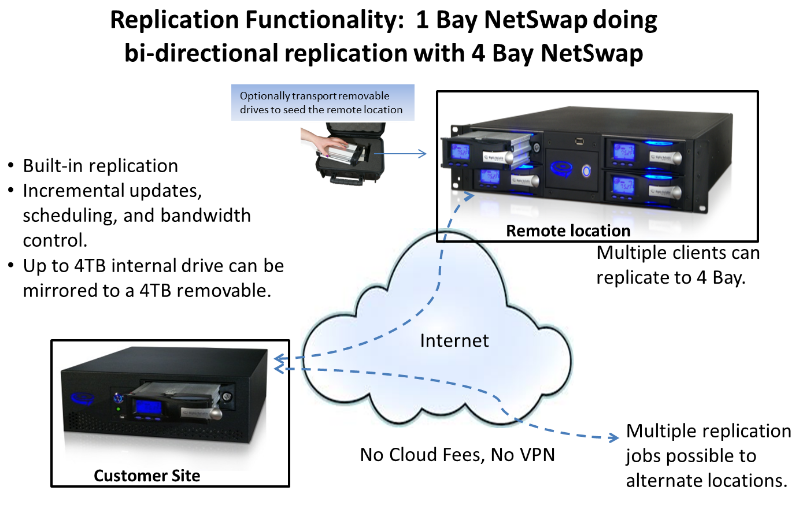
Highly Reliable Systems, based in Reno, Nevada, has added replication to their NetSwap and RAIDFrame removable drive Network Attached Storage (NAS) appliances. Intended for backup, these products provide removable drive and replication in one backup appliance. Replication is block level, incremental, encrypted, and scheduled.
The Netswap Plus and RAIDFrame NAS appliances can also mirror between internal and removable drives, providing 2 copies of local data at all times. The mirrored drives can be pulled while keeping the primary drive online, allowing almost any backup software to be used, since drives don’t appear to go offline during drive swaps. The removable drive can be transported for storage off-site or can be used to “seed” a remote location with up to 4TB of data per drive (12TB on RAIDFrame models). This feature is being called speed seed. It can be used even without an Internet connection or to supplement slow connections where full backups are too large to replicate in a timely fashion. Once seeded, uni or bi-directional replication is used to keep the remote site(s) up to date.
Unlike backup appliances that require monthly fees, NetSwap products can be placed in any location, such in a second office, with a managed service provider, or even at an owner’s home. Replication over the Internet is incremental and block level so only changes are replicated. Integrated compression and encryption insure the Internet is efficiently used and that customer data is protected without requiring external VPN tunnels. Encryption levels up to AES 256 are supported. Synchronization jobs can be throttled and scheduled so that Internet connectivity is not bottle necked during working hours.
Netswap products are available with 1, 2, or 4 removable drives and an 8 drive model is expected to be released in September 2013. The same replication functionality has been added to the RAIDFrame product line with up to 48TB of removable storage. Thomas Hoops, CTO for Highly Reliable Systems says the appliances are configured with any browser. “Simple port forwarding is used to allow Netswaps to see each other over the Internet and low cost dynamic DNS services are supported so that no static IP addresses are required.” Hoops also said the NAS appliances support multiple replication jobs and can notify administrators with e-mail alerts upon the success or failure of a job. The system detects open and changing files and makes sure replication occurs at a point in time using a snapshot to insure data integrity.
Netswaps groom off-site data on a set schedule, checking to make sure the data is readable and matches the source. The appliance will join a Windows domain, and use NTFS formatting to allow removable drives to cross plug with the company’s line of USB3 products. This allows simple emergency access to data from any Windows machine.
Important Note: In replication environments where files will be open and changing 24×7, the High-Rely “snapshot” feature can be used to track active file changes, providing integrity for the replication offsite. When using this snapshot feature the worst case scenario would require having twice the space on the sending side of replication job as is required for your full data set. For example, a very actively changing 1TB data set might require up to a 2TB drive on the sending side of the replication to allow room for the snapshot. While doubling space is overly conservative in most cases, it should be considered in drive size planning.

